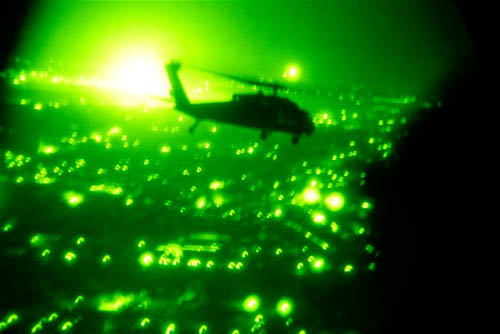 [Image: Google Maps view of Mosul Dam (bottom center) and the huge reservoir it creates].
[Image: Google Maps view of Mosul Dam (bottom center) and the huge reservoir it creates].
Dexter Filkins—author of, among other things, The Forever War—has a long new piece in the first 2017 issue of The New Yorker about the impending collapse of Iraq’s Mosul Dam.
The scale of the potential disaster is mind-boggling.
If the dam ruptured, it would likely cause a catastrophe of Biblical proportions, loosing a wave as high as a hundred feet that would roll down the Tigris, swallowing everything in its path for more than a hundred miles. Large parts of Mosul would be submerged in less than three hours. Along the riverbanks, towns and cities containing the heart of Iraq’s population would be flooded; in four days, a wave as high as sixteen feet would crash into Baghdad, a city of six million people. “If there is a breach in the dam, there will be no warning,” Alwash said. “It’s a nuclear bomb with an unpredictable fuse.”
Indeed, “hundreds of thousands of people could be killed,” according to a UN report cited by Filkins.
What’s interesting from a technical perspective is why the dam is so likely to collapse. It’s a question of foundations. The dam was built, Filkins writes, on rock “interspersed with gypsum—which dissolves in contact with water. Dams built on this kind of rock are subject to a phenomenon called karstification, in which the foundation becomes shot through with voids and vacuums.”
Filling those voids with grout is now a constant job, requiring dam engineers to pump huge amounts of cementitious slurry down into the porous rock in order to replace the dissolved gypsum.
 [Image: Mosul Dam spillway; photo by U.S. Army Staff Sgt. Brendan Stephens].
[Image: Mosul Dam spillway; photo by U.S. Army Staff Sgt. Brendan Stephens].
At one point, Filkins goes inside the dam where “engineers are engaged in what amounts to an endless struggle against nature. Using antiquated pumps as large as truck engines, they drive enormous quantities of liquid cement into the earth. Since the dam opened, in 1984, engineers working in the gallery have pumped close to a hundred thousand tons of grout—an average of ten tons a day—into the voids below.”
Finding and caulking these voids, Filkins writes, is “deeply inexact.” They are deep underground and remain unseen; they have to be inferred. The resulting process is both absurd and never-ending.
The engineers operating [the grout pumps] can’t see the voids they are filling and have no way of discerning their size or shape. A given void might be as big as a closet, or a car, or a house. It could be a single spacious cavity, requiring mounds of grout, or it could be an octopus-like tangle, with winding sub-caverns, or a hairline fracture. “We feel our way through,” [deputy director Hussein al-Jabouri] said, standing by the pump. Generally, smaller cavities require thinner grout, so Jabouri started with a milky solution and increased its thickness as the void took more. Finally, after several hours, he stopped; his intuition, aided by the pressure gauges, told him that the cavity was full. “It’s a crapshoot,” [civil engineer Azzam Alwash] told me. “There’s no X-ray vision. You stop grouting when you can’t put any more grout in a hole. It doesn’t mean the hole is gone.”
It’s hard not to think of a scene in Georges Perec’s novel Life: A User’s Manual, a scene I have written about before. There, a character named Emilio Grifalconi picks up an old, used table only to find that the support column at its center is “completely worm-eaten.” Slowly, painstakingly, operating by intuition, he fills the worm-eaten passages with a permanent adhesive, “injecting them with an almost liquid mixture of lead, alum and asbestos fiber.”
The table collapses anyway, alas, giving Grifalconi an idea: “dissolving what was left of the original wood” in order to “disclose the fabulous arborescence within, this exact record of the worms’ life inside the wooden mass: a static, mineral accumulation of all the movements that had constituted their blind existence, their undeviating single-mindedness, their obstinate itineraries; the faithful materialization of all they had eaten and digested as they forced from their dense surroundings the invisible elements needed for their survival, the explicit, visible, immeasurably disturbing image of the endless progressions that had reduced the hardest of woods to an impalpable network of crumbling galleries.”
Whether or not such a rhizomatic tangle of grout-filled chambers, linked “voids and vacuums” like subterranean grapes, could ever be uncovered and explored beneath the future ruins of a safely dismantled Mosul Dam is something I will leave for engineers.
 [Image: Mosul Dam water release; photo by U.S. Army Staff Sgt. Brendan Stephens].
[Image: Mosul Dam water release; photo by U.S. Army Staff Sgt. Brendan Stephens].
However, Filkins points out one possible solution that would sidestep all of this: this option, he writes, “which has lately gained currency, is to erect a ‘permanent’ seal of the existing dam wall—a mile-long concrete curtain dropped eight hundred feet into the earth.”
This would not be the only huge subterranean wall to be proposed recently: think of the “giant ice wall” under construction beneath the Fukushima nuclear power plant in Japan: “Japan is about to switch on a huge refrigeration system that will create a 1.5-km-long, underground frozen ‘wall,’ in hopes of containing the radioactive water that’s spilling out of the Fukushima nuclear power plant, which went into meltdown following the earthquake and tsunami of March 2011.”
Read more over at The New Yorker.
 [Image: U.S. helicopter over Baghdad,
[Image: U.S. helicopter over Baghdad, 
